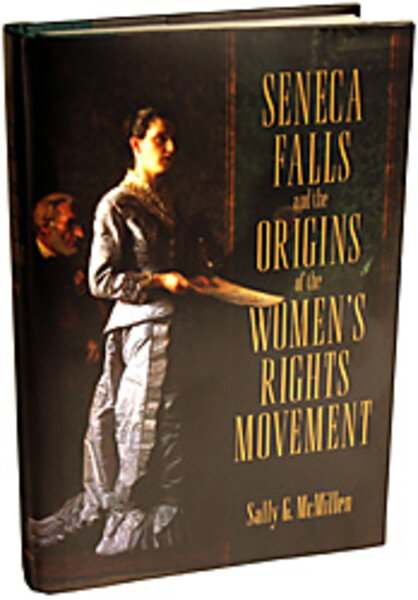Seneca Falls: The story of the women who changed the world
Loading...
"Cautious, careful people always casting about to preserve their reputation and social standing never can bring about reform," observed women's rights activist Susan B. Anthony.
Anthony knew whereof she spoke. She and her peers – the first generation of female activists – had doors slammed in their faces. They were shouted down when they rose to speak. Newspapers mocked them and clergymen called them instruments of the devil.
Even the majority of women took little interest in their efforts. And almost none of them lived long enough to see their cause prevail.
If you're looking for an upbeat, go-girlfriend view of history, Seneca Falls and the Origins of the Women's Rights Movements is not your book. The story that Sally McMillen tells is poignant, more a tale of self-sacrifice and delayed gratification than of triumph. But it's also a story of courage and conviction, about a small group of people who did, finally, change the world.
It was 1848, at a women's rights meeting in Seneca Falls, N.Y., that Elizabeth Cady Stanton rose to declare that "all men and women are created equal." And yet it was not until 1917 that the United States Constitution was amended to extend to women the right to vote.
Stanton and her peers spent their lives struggling toward that goal and the hard work they did altered everything about the American way of life. What is remarkable today, however, is how little we remember about these women.
That's a gap that McMillen, professor and chair of the history department at Davidson College in Davidson, N.C., hopes to help close with her solid examination of the Seneca Falls convention and the five decades that followed. She chooses four of the historic heroes of the women's movement – Stanton, Anthony, Lucretia Mott, and Lucy Stone – as her focal point.
The four women could not have been more different. Stanton, the well-to-do daughter of a judge, married and had seven children. Anthony, a born reformer, lived her life alone and saw marriage and family as a form of bondage.
Mott, a Quaker, was born on Nantucket, where the long absences of seafaring men encouraged the independence of women. Stone was a prodigy, a hardworking farm girl who, through sheer determination, became one of the nation's first female college graduates.
What these women had in common was an inability to accept the norms of their time. They lived in a world where women ceased to exist in the eyes of the law on the day that they married. "Physically they are persons; politically they are not," stated one California judge in 1871.
Where McMillen's book excels is in setting the lives and work of these women in context. She marches through the decades following Seneca Falls, evoking the 19th century in all of its turmoil and sometimes infuriating incomprehension. She shows how the Civil War and the furor over slavery slowed the advance of women's rights, even as she demonstrates how the industrial revolution accelerated the cause.
She paints a fascinating picture of the reactionary nature of American churches at the time. ("The worst enemy [women] have is in the pulpit," said Anthony, who also told a minister preaching female submission that if his mother were alive she "should lay you across her knee and give you a good spanking.")
And most of all, she reminds us – because it's hard for contemporary readers to grasp – how utterly powerless women were. They could be robbed, beaten, and raped by their husbands and would have no legal recourse. Yet most unquestioningly accepted that state and even considered it a form of "protection."
"So circumscribed have been her limits that she does not realize the misery of her condition," lamented Mott of her fellow women.
Despite their gumption, the lives of McMillen's reformers were not entirely heroic. Their internal quarrels and jealousy hurt their cause. Stanton's and Anthony's substantial egos sometimes clashed, particularly when the more appealing Stanton outshone the severe Anthony on speaking tours.
Stone, who once swore never to marry, ultimately found herself weighted down by a spouse who was neither a good provider nor a loyal husband. Also, Stone – who is largely overlooked today – became increasingly isolated from her colleagues by disagreements over approach. In her later years she found solace in housekeeping and jam-making.
For all the women it was a disappointment that full legal rights remained so elusive. They had to comfort themselves with the idea that another generation would savor their victory.
"We are sowing winter wheat, which other hands than ours will reap and enjoy," said Stanton toward the end of her life. The rest of us can never be grateful enough.
• Marjorie Kehe is the Monitor's book editor. Send comments to kehem@csps.com.






